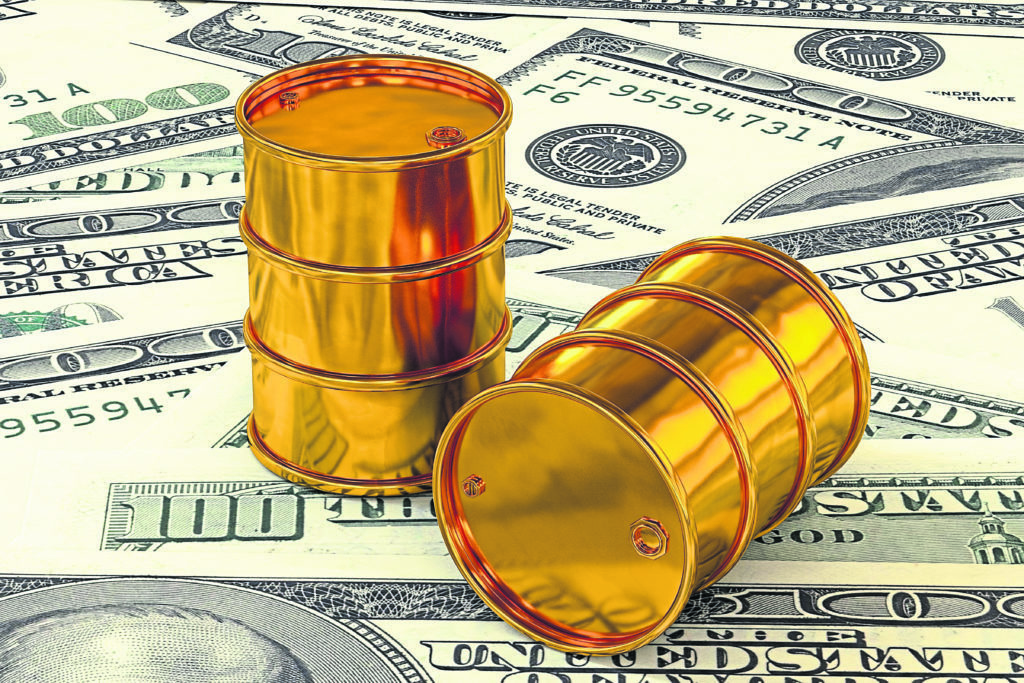
Oil posted its biggest ever intraday jump to more than $71 a barrel after a strike on a Saudi Arabian oil facility removed about 5% of global supplies, an attack the U.S. has blamed on Iran.
In an extraordinary start to trading on Monday, London’s Brent futures leapt almost $12 in the seconds after the open, the most in dollar terms since they were launched in 1988. Prices have since pulled back about half of that initial surge of almost 20%, but were still heading for the biggest advance in more than three years.
“We have never seen a supply disruption and price response like this in the oil market,” said Saul Kavonic, an energy analyst at Credit Suisse Group AG. “Political risk premium are now back on the oil market agenda.”
On the New York Mercantile Exchange, West Texas Intermediate futures were frozen for about two minutes after the scale of the move delayed the market open. They were 9.5% higher at $60.06 a barrel as of 1:39 p.m. in Singapore.
The dramatic move in oil reverberated around financial markets. Haven assets including gold, the yen and Treasuries surged on concern over the geopolitical fallout from the attacks. Currencies of commodity-linked nations including the Norwegian krone and the Canadian dollar also advanced. U.S. gasoline futures jumped almost 13% before paring their increase to around 9%.
State energy producer Saudi Aramco lost about 5.7 million barrels per day of output on Saturday after 10 unmanned aerial vehicles struck the world’s biggest crude-processing facility in Abqaiq and the kingdom’s second-biggest oil field in Khurais.
For oil markets, it’s the single worst sudden disruption ever, surpassing the loss of Kuwaiti and Iraqi petroleum supply in August 1990, when Saddam Hussein invaded his neighbor. It also exceeds the loss of Iranian oil output in 1979 during the Islamic Revolution, according to the International Energy Agency.
“The vulnerability of Saudi infrastructure to attacks, historically seen as a stable source of crude to the market, is a new paradigm the market will need to deal with,” said Virendra Chauhan, a Singapore-based analyst at industry consultant Energy Aspects Ltd. “At present, it is not known how long crude will be offline for.”
Saudi Arabia can restart a significant volume of the halted oil production within days, but needs weeks to restore full output capacity, people familiar with the matter said. The kingdom — or its customers — may use stockpiles to keep oil supplies flowing in the short term. Aramco could consider declaring itself unable to fulfill contracts on some international shipments — known as force majeure — if the resumption of full capacity at Abqaiq takes weeks.
That would rattle oil markets further and cast a shadow on Aramco’s preparations for what could be the world’s biggest initial public offering. It’s also set to escalate a showdown pitting Saudi Arabia and the U.S. against Iran, which backs proxy groups in Yemen, Syria and Lebanon. Iran-backed Houthi rebels in Yemen claimed credit for the attack, but U.S. President Donald Trump and Secretary of State Mike Pompeo have already pointed the finger directly at Iran.
Trump, who said the U.S. is “locked and loaded depending on verification” that Iran staged the attack, earlier authorized the release of oil from the nation’s emergency reserves. The IEA, which helps coordinate industrialized countries’ emergency fuel stockpiles, said it was monitoring the situation.
“No matter whether it takes Saudi Arabia five days or a lot longer to get oil back into production, there is but one rational takeaway from this weekend’s drone attacks on the Kingdom’s infrastructure — that infrastructure is highly vulnerable to attack, and the market has been persistently mispricing oil,” Ed Morse, Citigroup Inc.’s global head of commodities research, wrote in a research note.
Brent jumped more than 19% to $71.95 a barrel on ICE Futures Europe, its biggest gain in percentage terms since 1991. In the ensuing hours, it pared that advance to trade 10.7% higher at $66.66 a barrel. The global benchmark crude could rise above $75 a barrel if the outage at Abqaiq lasts more than six weeks, Goldman Sachs Group Inc. said in a note.
Trading in WTI was frozen for a few minutes because of a so-called circuit breaker, which is triggered by a gain of more than 7%. When they finally opened, futures jumped as much as 15.5% to $63.34, the most since 2008.
The attacks “set the stage for a Monday morning mini-massacre of any market participants holding short positions or bearish expectations,” said John Driscoll, chief strategist at JTD Energy Services Ltd. in Singapore. The “price move was exacerbated by the unprecedented magnitude of the outage on the world’s key supplier and the potential for escalation of geopolitical skirmishes involving the U.S., Saudi and Iran.”
The drama wasn’t limited to flat prices. The spread between Brent and WTI widened as much as 37%, showing that the oil spike will affect global prices more than those in the U.S., where shale output and ample supplies provide more of a buffer.
Brent’s 6-month backwardation jumped to the highest level since September 2013 as the outage raises concerns about obtaining near-term supplies. And the call-put skew flipped into positive territory for the first time since 2018, indicating that options traders are willing to pay more to place a bet on prices rising rather than falling.